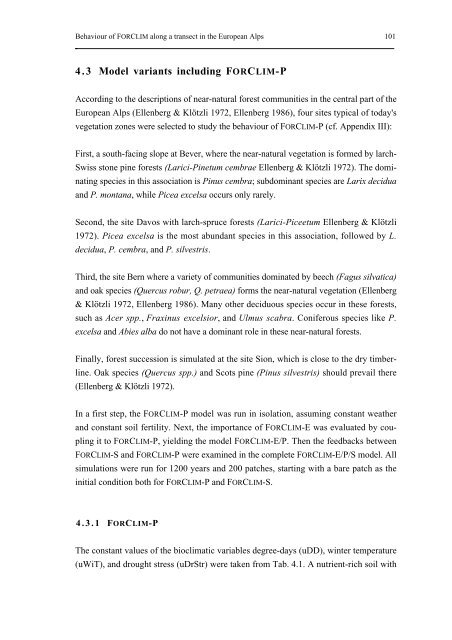On the Ecology of Mountainous Forests in a Changing Climate: A ...
On the Ecology of Mountainous Forests in a Changing Climate: A ...
On the Ecology of Mountainous Forests in a Changing Climate: A ...
You also want an ePaper? Increase the reach of your titles
YUMPU automatically turns print PDFs into web optimized ePapers that Google loves.
Behaviour <strong>of</strong> FORCLIM along a transect <strong>in</strong> <strong>the</strong> European Alps 101<br />
4.3 Model variants <strong>in</strong>clud<strong>in</strong>g FORCLIM-P<br />
Accord<strong>in</strong>g to <strong>the</strong> descriptions <strong>of</strong> near-natural forest communities <strong>in</strong> <strong>the</strong> central part <strong>of</strong> <strong>the</strong><br />
European Alps (Ellenberg & Klötzli 1972, Ellenberg 1986), four sites typical <strong>of</strong> today's<br />
vegetation zones were selected to study <strong>the</strong> behaviour <strong>of</strong> FORCLIM-P (cf. Appendix III):<br />
First, a south-fac<strong>in</strong>g slope at Bever, where <strong>the</strong> near-natural vegetation is formed by larch-<br />
Swiss stone p<strong>in</strong>e forests (Larici-P<strong>in</strong>etum cembrae Ellenberg & Klötzli 1972). The dom<strong>in</strong>at<strong>in</strong>g<br />
species <strong>in</strong> this association is P<strong>in</strong>us cembra; subdom<strong>in</strong>ant species are Larix decidua<br />
and P. montana, while Picea excelsa occurs only rarely.<br />
Second, <strong>the</strong> site Davos with larch-spruce forests (Larici-Piceetum Ellenberg & Klötzli<br />
1972). Picea excelsa is <strong>the</strong> most abundant species <strong>in</strong> this association, followed by L.<br />
decidua, P. cembra, and P. silvestris.<br />
Third, <strong>the</strong> site Bern where a variety <strong>of</strong> communities dom<strong>in</strong>ated by beech (Fagus silvatica)<br />
and oak species (Quercus robur, Q. petraea) forms <strong>the</strong> near-natural vegetation (Ellenberg<br />
& Klötzli 1972, Ellenberg 1986). Many o<strong>the</strong>r deciduous species occur <strong>in</strong> <strong>the</strong>se forests,<br />
such as Acer spp., Frax<strong>in</strong>us excelsior, and Ulmus scabra. Coniferous species like P.<br />
excelsa and Abies alba do not have a dom<strong>in</strong>ant role <strong>in</strong> <strong>the</strong>se near-natural forests.<br />
F<strong>in</strong>ally, forest succession is simulated at <strong>the</strong> site Sion, which is close to <strong>the</strong> dry timberl<strong>in</strong>e.<br />
Oak species (Quercus spp.) and Scots p<strong>in</strong>e (P<strong>in</strong>us silvestris) should prevail <strong>the</strong>re<br />
(Ellenberg & Klötzli 1972).<br />
In a first step, <strong>the</strong> FORCLIM-P model was run <strong>in</strong> isolation, assum<strong>in</strong>g constant wea<strong>the</strong>r<br />
and constant soil fertility. Next, <strong>the</strong> importance <strong>of</strong> FORCLIM-E was evaluated by coupl<strong>in</strong>g<br />
it to FORCLIM-P, yield<strong>in</strong>g <strong>the</strong> model FORCLIM-E/P. Then <strong>the</strong> feedbacks between<br />
FORCLIM-S and FORCLIM-P were exam<strong>in</strong>ed <strong>in</strong> <strong>the</strong> complete FORCLIM-E/P/S model. All<br />
simulations were run for 1200 years and 200 patches, start<strong>in</strong>g with a bare patch as <strong>the</strong><br />
<strong>in</strong>itial condition both for FORCLIM-P and FORCLIM-S.<br />
4.3.1 FORCLIM-P<br />
The constant values <strong>of</strong> <strong>the</strong> bioclimatic variables degree-days (uDD), w<strong>in</strong>ter temperature<br />
(uWiT), and drought stress (uDrStr) were taken from Tab. 4.1. A nutrient-rich soil with















